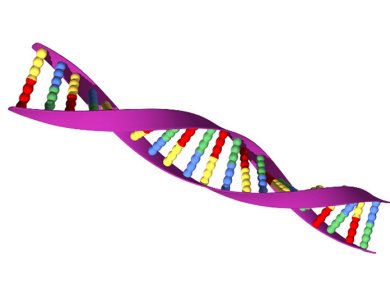The Human Genome Project, terminated in 2003, identified more than 20,000 genes in the DNA. These sequences make up just over 1 % of the total genome. The function of all other parts, the so-called junk DNA, that is not protein-coding, was very poorly understood. Launched as a follow-up project for the Human Genome Project, the Encyclopedia of DNA Elements (Encode) aimed to study the noncoding DNA’s biological interactions. The project’s results indicate that about 80 % of the total human genome possesses a specific biological function.
More than 400 scientists from 32 different research institutions in the UK, US, Spain, Singapore and Japan used many experimental methods, ranging from the isolation and sequencing of transcribed RNAs, studies of the modifications of histones to the identification of silent genes, to analyze the genome’s function in various cell types. Their experimental results revealed the existence of many regulatory elements – more than 70,000 promoter regions and almost 400,000 enhancer regions – in parts of the formerly called junk DNA. These regulatory elements act as switches, switching genes and protein production on and off under certain conditions.
The highly complex regulatory system can explain how the human biological complexity can be achieved with few protein-coding genes. A long-term scientific goal of this genetic research project is a better understanding of the mechanisms of genetic diseases and the development of efficient therapies.
Also of interest:
- Pharmacogenetics and Individualized Therapy
Anke-Hilse Maitland-van der Zee, Ann K. Daly
John Wiley & Sons, Hoboken, USA, 2012
ISBN: 978-0-470-43354-6 - Pharmacogenomics in Clinical Therapeutics
Loralie J. Langman, Amitava Dasgupta
John Wiley & Sons, Hoboken, USA, 2012
ISBN: 978-0-470-65734-8 - Genomics in Drug Discovery and Development
Dimitri Semizarov, Eric Blomme
John Wiley & Sons, Hoboken, USA, 2008
ISBN: 978-0-470-09604-8 - Bioinformatics and Functional Genomics
Jonathan Pevsner
John Wiley & Sons, Hoboken, USA, 2008
ISBN: 978-0-470-08585-1 - Molecular Analysis and Genome Discovery
Ralph Rapley, Stuart Harbron
John Wiley & Sons, Hoboken, USA, 2011
ISBN: 978-0-470-75877-9 - Tag-based Next Generation Sequencing
Matthias Harbers (Editor), Guenter Kahl (Editor)
Wiley-VCH, Weinheim, Germany, 2012
ISBN: 978-3-527-32819-2 - Next-Generation Genome Sequencing: Towards Personalized Medicine
Michal Janitz (Editor)
Wiley-VCH, Weinheim, Germany, 2008
ISBN: 978-3-527-32090-5 - From Defining Bioinformatics and Pharmacogenomics to Developing Information-Based Medicine and Pharmacotyping in Health Care,
Ioannis S. Vizirianakis,
Pharmaceutical Sciences Encyclopedia: Drug Discovery, Development, and Manufacturing
John Wiley & Sons, Hoboken, USA, 2010
DOI: 10.1002/9780470571224.pse295 - SNPs: Single Nucleotide Polymorphisms and Pharmacogenomics: Individually Designed Drug Therapy
Anke-Hilse Maitland-van der Zee, Brian J. Puckett, Steven G. Terra, Joe Walker
John Wiley & Sons, Hoboken, USA, 2010
Burger’s Medicinal Chemistry, Drug Discovery and Development
DOI: 10.1002/0471266949.bmc072.pub2 - Bioinformatics: Its Role in Drug Discovery
David J. Parry-Smith
John Wiley & Sons, Hoboken, USA, 2003
Burger’s Medicinal Chemistry, Drug Discovery and Development
DOI: 10.1002/0471266949.bmc008 - Wiley Interdisciplinary Reviews: Systems Biology and Medicine
- Molecular Modelling of G Protein-Coupled Receptors Through the Web,
Molec. Inform. 2012.
DOI: 10.1002/minf.201100162 - Free Energy Calculations by the Molecular Mechanics Poisson−Boltzmann Surface Area Method
Molec. Inform. 2012.
DOI: 10.1002/minf.201100135




